Shot down today... a most novel experience: What Battle of Britain hero wrote in extraordinary diary
-
•George Barclay wrote it despite MoD's security ban on such journals
-
•He joined RAF aged 20 and survived being shot down THREE times
-
•Airman escaped occupied France by turning his uniform inside out
-
•Killed in action, aged 22, commanding Hurricane squadron at El Alamein
-
•His family unaware of diary, which has now been published, until recently
By Luke Salkeld
PUBLISHED: 18:00, 27 November 2012 | UPDATED: 01:33, 28 November 2012
In his short career, he survived being shot down from the sky three times and escaped from the Nazis in occupied France.
Now, 70 years after his death, the diary of brave Battle of Britain fighter pilot George Barclay has brought his remarkable escapades back to life.
In what is thought to be the only record of its kind, the heroic Squadron Leader chronicles taking to the skies in the cockpits of Hurricanes and Spitfires – and even describes being shot down for the first time as a ‘most novel experience’.
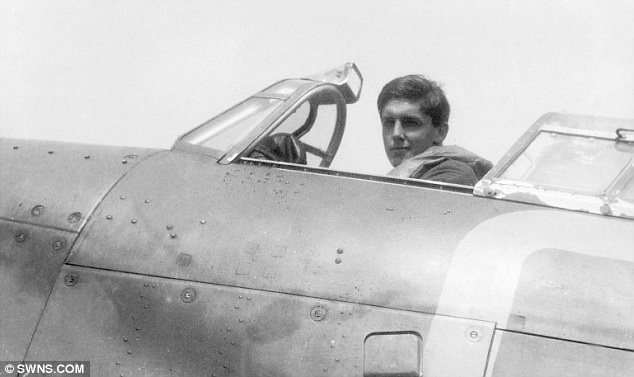
Battle of Britain pilot George Barclay in the cockpit. He flew Hurricanes and Spitfires in the Battle of Britain, the Sweeps over France and the North African campaign - and survived being shot down three times
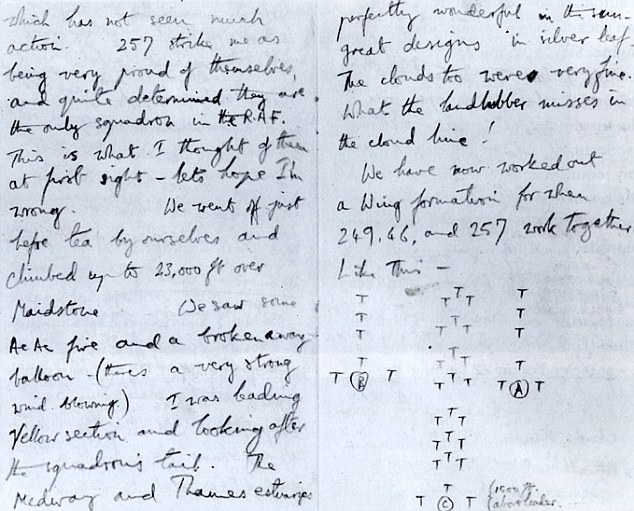
A page from the secret diary of Battle of Britain pilot George Barclay. George kept a day-to-day record detailing his life in the skies. In this entry he illustrates wing formations for their next outing. He writes: 'We went off just before tea by ourselves and climbing up to 23,000ft over Maidstone... I was leading yellow section and looking after the squadron's tail'
Pilots were banned from keeping diaries for security reasons, so Barclay resorted to secretly recording his thoughts in exercise books.
His entries display the stiff upper lip that helped our heavily outnumbered pilots win the crucial aerial battle that thwarted Hitler’s invasion plans.
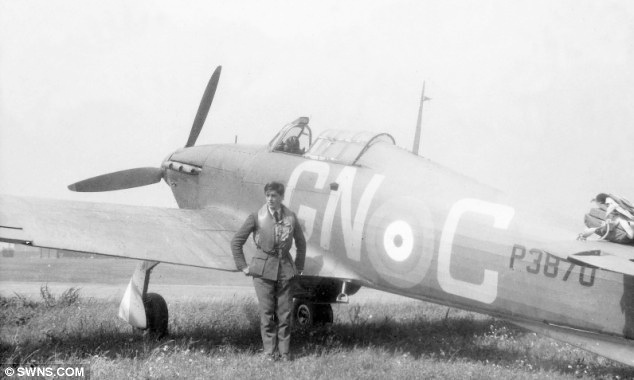
Battle of Britain pilot George Barclay with his Hurricane Mk1
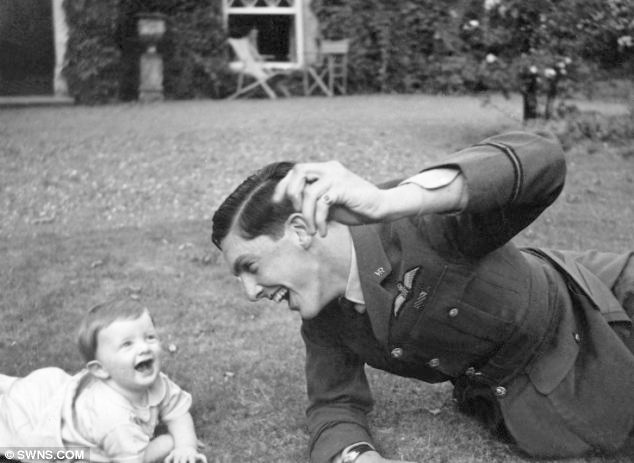
Battle of Britain pilot George Barclay with his godson Leo in 1940
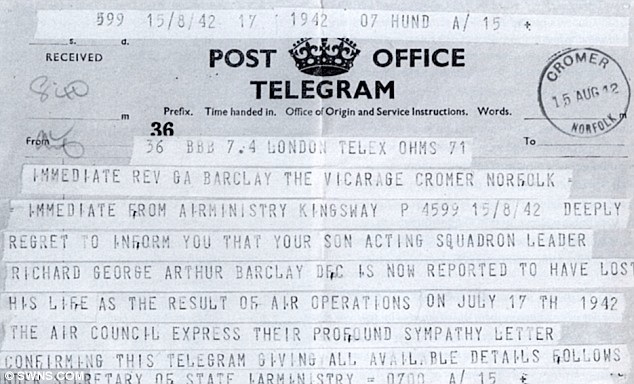
The telegram sent by the RAF informing of the death of Battle of Britain pilot George Barclay
But tragically, they end before the Allies secured victory. Barclay was killed in action aged 22, commanding a Hurricane squadron during the 1942 Battle of El Alamein in Egypt.
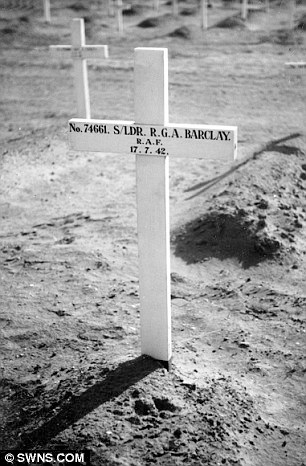
The grave of Battle of Britain pilot George Barclay in El Alamein
Previously his squadron had played a key role in the 1940 Battle of Britain, and it was then that the Cambridge-educated pilot began secretly putting pen to paper.
His first entry in September of that year begins: ‘Yesterday evening we were told we were to move to North Weald, Essex, today to relieve the war-weary and much shot up 56 Squadron. We grabbed beds in the hut and slept soundly, wondering what the morrow held in store.’
Just six days later, on September 7, Barclay’s plane suffered a direct hit as he duelled with a group of German Me109 aircraft. But remarkably, his stricken plane landed ‘wheels up’ in a field near his airfield.
Of the 12 British planes in his patrol that day, one pilot died and four – including Barclay – were injured.
He wrote afterwards: ‘The odds today have been unbelievable (and we are all really very shaken!). There are bombs and things falling around tonight and a terrific gun barrage. Has a blitz begun?’
After being shot down a second time on November 29 at 22,000ft he recalled: ‘I was shot down today – a most novel experience...
‘As I fell out and down on my back one of my boots fell off, apparently to me falling upwards as I left it behind.’

George Barclay (far right) as a child with his brothers Charlie and Richard
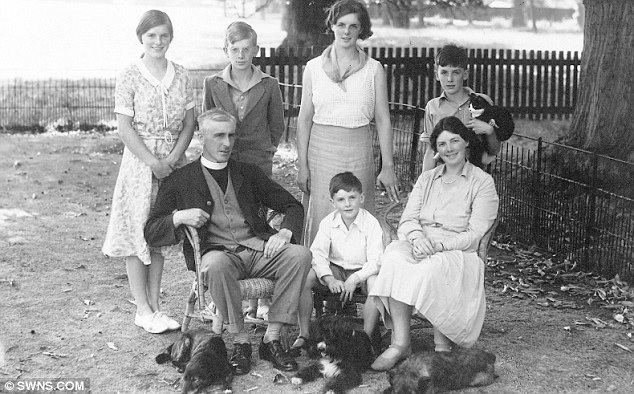
George Barclay (back right) as a child with his mother, father, brothers and sisters
He was shot down for a third time on September 20, 1941, after being ‘jumped’ by five Me109s as he flew over France in a Spitfire. His parents, Reverend Gilbert Barclay and wife Dorothy – who lost another son, Charles, in the war – received a letter reporting that he was missing.
'There are bombs falling all around'
It stated: ‘He was very popular in the Officers’ Mess and his cheerful personality will be greatly missed.’
Remarkably, however, Barclay had survived, and ended up in a French field. He turned his uniform inside out to hide the insignia that would reveal his identity, and pretended to be a farm worker as Nazis came looking for him.
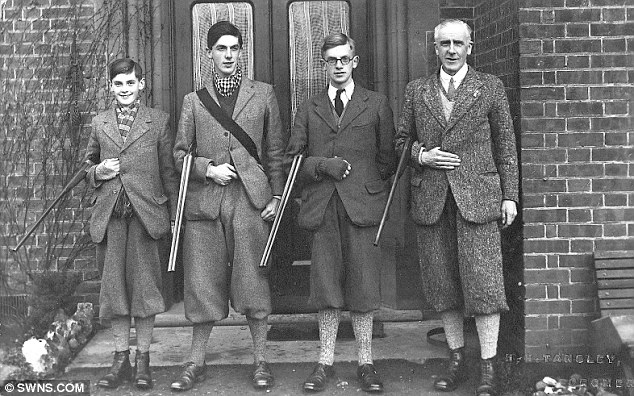
George Barclay (second left) with his brothers Richard (far left), Charles (second right) and father Gilbert (far right) getting ready to go out on a shoot
PROTECTING THE SKIES: THE BATTLE OF BRITAIN
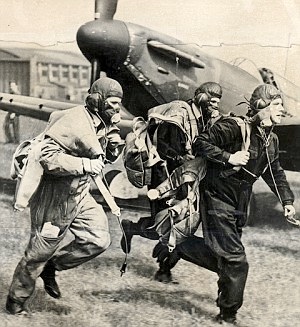
The Battle of Britain was the German air force's attempt to gain air superiority over the RAF from July to September 1940.
It was one of the turning points of World War Two and prevented Germany from invading Britain.
The battle began in mid-July with Luftwaffe concentrating on attacking shipping in the English Channel and attacking coastal towns and defences.
From 12 August, Hermann Goering, one of the leaders of the Nazi regime, shifted his focus to the destruction of the RAF, attacking airfields and radar bases. (Pictured above, RAF scrambling to their planes in 1940.)
Convinced that Fighter Command was now close to defeat, he also tried to force air battles between fighter planes to break British strength.
However, Goering grew frustrated by the large number of British planes that were still fighting off his attacks.
Luftwaffe switched tactics again and, on Hitler's orders, set about destroying London and other major cities.
Eleven days later, on what became 'Battle of Britain Day', the RAF decimated the huge incoming Luftwaffe formations in the skies above London and the south coast.
He was helped by many French civilians and managed to escape through Spain over a three-month period. His diary entry on September 26 describes how he was given shelter by a French woman called Madame Salingue.
He wrote: ‘I was given a very friendly welcome. Immediately we arrived Madame cooked us two eggs and chips each.
'Apparently that is what the troops asked for before Dunkirk. Burbare had quite a large number of British troops billeted there and wherever I went I was shown photos of them. The French liked them very much.’
After returning home to Cromer, Norfolk, Barclay was put in charge of battle-weary 238 Squadron and led them out to patrol the El Alamein area of Egypt – where he was fatally shot down.
He received a posthumous salute from England in January 1943, when he was Mentioned in Despatches in New Year Honours.
His parents did not discover his diary until a few years after his death. A version was published in the 1970s, but an extended edition has now been compiled by historians and his brother Richard, now 86, a retired banking director.
The father of four from Minchinhampton, Gloucestershire, said: ‘We had no idea that he was writing a diary, he never mentioned it when he was on leave.
‘It tells of squadron life and the numerous pressures and battles which demonstrate the extraordinary dedication and self-sacrifice of all the young men in the country.
He wrote his diary in such a straightforward way, you really feel as if you are sat next to him on the plane.’
The book’s editor, Humphrey Wynn, a historian with the Ministry of Defence Air Historical Branch, said it was the only daily account of the Battle of Britain kept by a pilot of either side.
Battle of Britain Pilot: The Self-Portrait of an RAF Fighter Pilot and Escaper is on sale now, priced £25.
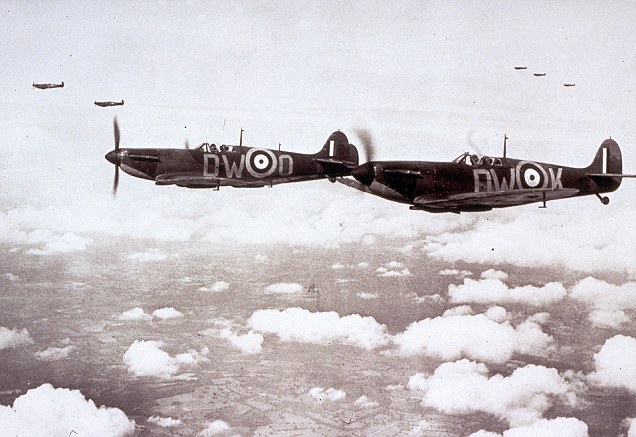
On 10 July 1940, German and British air forces went to war and the Battle of Britain began
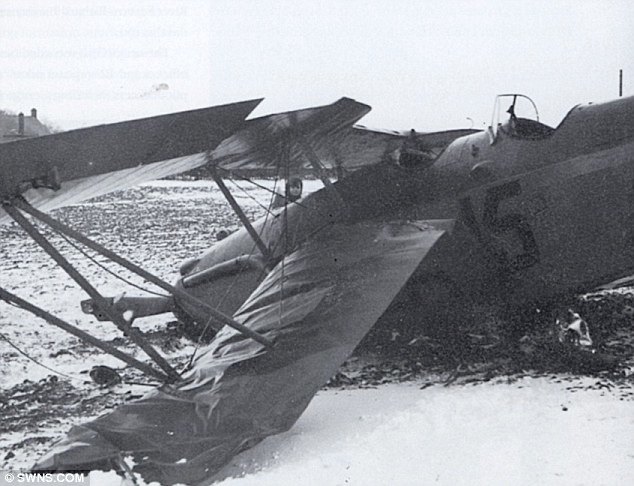
The Hawker Hind which Battle of Britain pilot George Barclay crashed during training